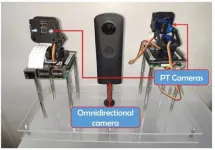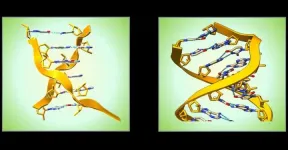(Press-News.org) BOSTON - B cells are the immune cells responsible for creating antibodies, and most B cells, known as B2 cells, produce antibodies in response to a pathogen or a vaccine, providing defense and immunity against infections. But a small subset of long-lived B cells, known as B1 cells, are quite different from their short-lived cousins, the B2 cells. Instead of producing antibodies in response to invaders, they spontaneously make antibodies that perform vital housekeeping functions, such as removing waste like oxidized LDL cholesterol from the blood.
Like all the cells in the body, B1 and B2 cells have the same DNA, and therefore the same starting set of instructions. It is through epigenetic modifications, which open and close different areas of the genome to the machinery that reads the genetic instructions, that the same genome can be used to create unique instructions for each cell type. Understanding how the different epigenetic landscapes - the changes in instructions - allows for these differences in such similar cells is both an important fundamental question in immunology and can help scientists better understand diseases linked to B cells' dysregulation.
Shiv Pillai, MD, PhD, a core member of the Ragon Institute of MGH, MIT and Harvard, studied the DNA modifications present in both cell types during different stages of development to identify an epigenetic signature that may determine whether a cell becomes a B1 or a B2 cell. This work was published recently in the journal END
Epigenetic changes drive the fate of a B cell
Scientists at the Ragon Institute of MGH, MIT and Harvard discover epigenetic changes unique to B cells and B cell subtypes
2021-05-13
ELSE PRESS RELEASES FROM THIS DATE:
Politically polarized brains share an intolerance of uncertainty
2021-05-13
PROVIDENCE, R.I. [Brown University] -- Since the 1950s, political scientists have theorized that political polarization -- increased numbers of "political partisans" who view the world with an ideological bias -- is associated with an inability to tolerate uncertainty and a need to hold predictable beliefs about the world.
But little is known about the biological mechanisms through which such biased perceptions arise.
To investigate that question, scientists at Brown University measured and compared the brain activity of committed partisans (both liberals and conservatives) as ...
Two-in-one: Wide-angle monitoring meets high-resolution capture in new camera platform
2021-05-13
If you're a fan of spy movies, you've probably come across scenes where the intelligence agents try to identify or detect a perpetrator using some sophisticated image enhancement technology on surveillance camera images. While the idea behind surveillance cameras and object detection is the same in real life, unlike in movies, there is often a trade-off between the camera's field-of-view and its resolution.
Surveillance cameras are typically required to have a wide field-of-view to make the detection of a threat more likely. Due to this, omnidirectional ...
The first frost is the deepest
2021-05-13
The first frost of autumn may be grim for gardeners but the latest evidence reveals it is a profound event in the life of plants.
The discovery may affect how we grow crops in a fluctuating climate and help us better understand molecular mechanisms in animals and humans.
Much of our understanding of how plants register temperature at a molecular level has been gained from the study of vernalization - the exposure to an extended period of cold as a preparation for flowering in spring.
Experiments using the model plant Arabidopsis have shown how this prolonged period of cold lifts the brake on flowering, a gene called FLC. This biochemical brake also involves another molecule COOLAIR which is antisense to FLC. This means it lies on the ...
Knowledge gaps on opioid use after surgery offer opportunities for improving patient education
2021-05-13
Researchers at Hospital for Special Surgery (HSS) have identified gaps in patient knowledge about pain management and opioid use before total hip replacement, including misconceptions about how much pain relief to expect from opioids after surgery, how to use multiple modes of pain relief (multimodal analgesia) safely and effectively, and proper opioid storage and disposal. These findings were presented at the 2021 Spring American Society of Regional Anesthesia and Pain Medicine (ASRA) Annual Meeting.1
"Patients who are not taught about opioids and pain management may have difficulty with pain control and worse functional outcomes after total ...
Study identifies risk factors for pediatric opioid dependence after surgery
2021-05-13
Researchers at Hospital for Special Surgery (HSS) have identified risk factors for persistent opioid use after surgery in pediatric patients.1 Study findings were presented at the 2021 Spring American Society of Regional Anesthesia and Pain Medicine (ASRA) Annual Meeting.
Previous research indicates that prescription patterns for opioids after surgery in children and adolescents may be associated with long-term use and abuse.2
"Pediatric patients have developing brains that are uniquely vulnerable to addiction, and we need to learn to treat their pain safely without putting them at additional ...
UChicago study finds lasofoxifene a promising treatment for resistant breast cancer
2021-05-13
In a study carried out in mice at the University of Chicago, researchers found that lasofoxifene outperformed fulvestrant, the current gold-standard drug, in reducing or preventing primary tumor growth. It also was more effective at preventing metastasis in the lung, liver, bone and brain, the four most common areas for this cancer to spread.
Additionally, while fulvestrant and similar drugs often cause unwanted, menopausal-like side effects, lasofoxifene prevents some of these symptoms. The research was published on May 13 in END ...
Understanding how people make sense of the news they consume
2021-05-13
How people consume news and take actions based on what they read, hear or see, is different than how human brains process other types of information on a daily basis, according to researchers at the University of Missouri School of Journalism. While the current state of the newspaper industry is in flux, these journalism experts discovered people still love reading newspapers, and they believe a newspaper's physical layout and structure could help curators of digital news platforms enhance their users' experiences.
"Many people still love print newspapers, and to an extent, we also see that they like the digital replicas of print newspapers as much as they do the physical version," said Damon Kiesow, a professor of journalism professions and co-author on the study. "But we believe there ...
A Z-RNA nanoswitch encoded by "junk DNA" turns-off immune responses against self
2021-05-13
In a paper published in the May 13th, 2021 issue of PLOS Genetics, a Z-RNA nanoswitch that regulates interferon immune responses is described. The switch, less than 5 nanometer in length, is based on sequences, called flipons, that change outcomes by altering their three dimensional conformation. The Z-RNA nanoswitch flips from the shorter right-handed A-RNA helix ("on") to the longer left-handed Z-RNA helix ("off"). The flip ends immune responses against self RNAs, but not against viruses. Surprisingly, the Z-RNA nanoswitch sequence is encoded by "junk DNA". The Z-RNA nanoswitch is used by some cancers to silence anti-tumor immune responses. In other cases, a malfunction of the Z-RNA nanoswitch causes inflammatory disease.
In the ...
A sibling-guided strategy to capture the 3D shape of the human face
2021-05-13
A new strategy for capturing the 3D shape of the human face draws on data from sibling pairs and leads to identification of novel links between facial shape traits and specific locations within the human genome. Hanne Hoskens of the Department of Human Genetics at Katholieke Universiteit in Leuven, Belgium, and colleagues present these findings in the open-access journal PLOS Genetics.
The ability to capture the 3D shape of the human face--and how it varies between individuals with different genetics--can inform a variety of applications, including understanding human evolution, planning for surgery, and forensic sciences. ...
Two regions in the canine genome explain one third of the risk of rare blood cancer
2021-05-13
Mutations in two genetic regions in dogs explain over one third of the risk of developing an aggressive form of hematological cancer, according to a study led by Jacquelyn Evans and Elaine Ostrander at the National Human Genome Research Institute in Maryland, USA and colleagues. The study, which combined multiple sequencing techniques to investigate histiocytic sarcoma in retriever dogs, publishes May 13 in the open-access journal PLOS Genetics.
Histiocytic sarcoma is an aggressive cancer of immune cells, and although extremely rare in humans, it affects around one-in-five flat-coated retrievers. Genome-wide association surveys of 177 affected and 132 unaffected flat-coated ...
LAST 30 PRESS RELEASES:
Orthopedics can play critical role in identifying intimate partner violence
Worms as particle sweepers
Second spider-parasitic mite described in Brazil
January 2026 issues of APA journals feature new research on autism, pediatric anxiety, psychedelic therapy, suicide prevention and more
Private equity acquired more than 500 autism centers over the past decade, new study shows
New cervical cancer screening guidelines from the US Department of Health and Human Services
Estimated burden of COVID-19 illnesses, medical visits, hospitalizations, and deaths in the US from October 2022 to September 2024
Smartphone use during school hours by US youth
Food insecurity and adverse social conditions tied to increased risk of long COVID in children
Earliest, hottest galaxy cluster gas on record could change our cosmological models
Greenland’s Prudhoe Dome ice cap was completely gone only 7,000 years ago, first GreenDrill study finds
Scientific validity of blue zones longevity research confirmed
Injectable breast ‘implant’ offers alternative to traditional surgeries
Neuroscientists devise formulas to measure multilingualism
New prostate cancer trial seeks to reduce toxicity without sacrificing efficacy
Geometry shapes life
A CRISPR screen reveals many previously unrecognized genes required for brain development and a new neurodevelopmental disorder
Hot flush treatment has anti-breast cancer activity, study finds
Securing AI systems against growing cybersecurity threats
Longest observation of an active solar region
Why nail-biting, procrastination and other self-sabotaging behaviors are rooted in survival instincts
Regional variations in mechanical properties of porcine leptomeninges
Artificial empathy in therapy and healthcare: advancements in interpersonal interaction technologies
Why some brains switch gears more efficiently than others
UVA’s Jundong Li wins ICDM’S 2025 Tao Li Award for data mining, machine learning
UVA’s low-power, high-performance computer power player Mircea Stan earns National Academy of Inventors fellowship
Not playing by the rules: USU researcher explores filamentous algae dynamics in rivers
Do our body clocks influence our risk of dementia?
Anthropologists offer new evidence of bipedalism in long-debated fossil discovery
Safer receipt paper from wood
[Press-News.org] Epigenetic changes drive the fate of a B cellScientists at the Ragon Institute of MGH, MIT and Harvard discover epigenetic changes unique to B cells and B cell subtypes


